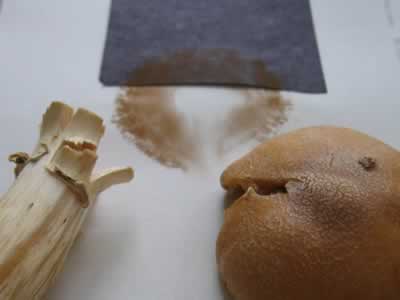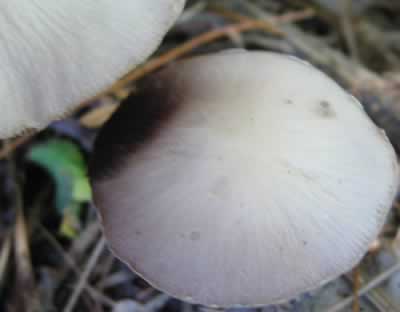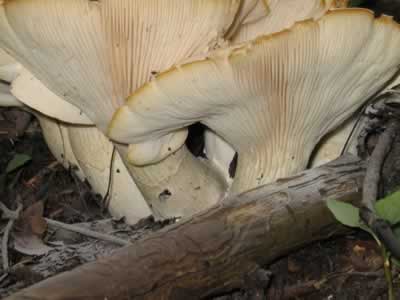Spore color
Spore color is probably the most important distinguishing characteristic among all the mushrooms that you will encounter on a foray.
For all the mushroom producing fungi, spore color is a highly conserved feature across the taxonomic tree. Many field guides and other reference books will divide their sections based on spore color differences. When you have determined the spore color of a particular mushroom, you can immediately draw major conclusions on its taxonomic placement.
Unfortunately, spore color can be the most difficult feature to identify in the field. Simple observation of the spore-bearing surface of a mushroom is typically not enough to determine its spore color, as many mushrooms have pigmented gills or pores even when immature. In the absence of particular field signs, determining spore color requires a procedure that can take hours to produce adequate information. The procedure is called gathering a sporeprint.
Listed below are some ways to determine the all important spore color...
Sporeprints
A sporeprint is the imprint left by millions of spores that have been projected on a surface by the fertile tissues of the mushroom cap.
To aquire a sporeprint, you will be placing a recently matured mushroom cap on a paper or clear plastic surface. It can take an hour, or it could take all day, but eventually a layer of spores should deposit on the surface.
If you use paper, you will want to use pure white, and I recommend a contrasting black portion as shown to the right. I like to use recipe cards with alternating white and black bands, then rubber-banding a cap onto the card and placing it in my basket.

Spore deposit on lower caps
Preparing sporeprints takes time and effort. In many cases you may not be willing to go through the trouble of preparing them. Fortunately, there are many situations in which you won't need to!
In the case of mushrooms that appear in clusters or troops, you have a good chance of finding a spore deposit on caps that are below another's gills. Depending on the color of the cap and the color of the spores, the deposit could be very obvious and save you alot of trouble!
The photo to the right shows a black sporeprint, which suggests that the mushroom belongs to the Strophariaceae or Coprinaceae.

Spore deposit on other materials
Even if the mushroom you are trying to ID is not in clusters, sometimes a spore deposit is so heavy that it covers the ground beneath it.
Typically, spores are designed to catch the breeze and be carried away. But as you can see in the photo to the right, there are millions of spores that are simply sitting on the ground under these giant Clitocybes.
Another good but often unreliable place to look for deposits is the stem and ring (if present). If the spore color is significantly different from the tissue color, it may be of use. It is easy to mistake actual tissue color differences for spore deposits, however, so this isn't the best choice for determining spore color.
